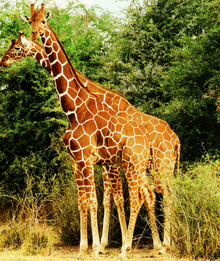
Back সমকামিতা দেখা যাওয়া স্তন্যপায়ী প্রাণীদের তালিকা Bengali/Bangla فهرست پستانداران با نمایش رفتار همجنسگرایی Persian

This is a list of animals for which there is documented evidence of homosexual behavior. These animals have been observed practicing homosexual courtship, sexual behavior, affection, pair bonding, or parenting.
Bruce Bagemihl writes that the presence of same-sex sexual behavior was not officially observed on a large scale until the 1990s due to possible observer bias caused by social attitudes towards LGBT people, which made homosexuality in animals a taboo subject.[3][4] He devotes three chapters, "Two Hundred Years at Looking at Homosexual Wildlife", "Explaining (Away) Animal Homosexuality", and "Not For Breeding Only" in his 1999 book Biological Exuberance to the "documentation of systematic prejudices" where he notes "the present ignorance of biology lies precisely in its single-minded attempt to find reproductive (or other) "explanations" for homosexuality, transgender, and non-procreative and alternative heterosexualities.[5] Petter Bøckman, academic adviser for the Against Nature? exhibit, stated "[M]any researchers have described homosexuality as something altogether different from sex. They must realise that animals can have sex with who they will, when they will and without consideration to a researcher's ethical principles". Homosexual behavior is found amongst social birds and mammals, particularly the sea mammals and the primates.[4]
Animal sexual behavior takes many different forms, even within the same species and the motivations for and implications of their behaviors have yet to be fully understood. Bagemihl's research shows that homosexual behavior, not necessarily sexual activity, has been documented in about 500 species as of 1999, ranging from primates to gut worms.[3][6] Homosexuality in animals is controversial with some social conservatives because it asserts the naturalness of homosexuality in humans, while others counter that it has no implications and is nonsensical to equate animal behavior to morality.[7][8] Animal preference and motivation is inferred from behavior, thus homosexual behavior has been given a number of terms over the years. Modern research[9][10][11][12] applies the term homosexuality to all sexual behavior (copulation, genital stimulation, mating games and sexual display behavior) between animals of the same sex.
This is a list of some mammals that have been recorded engaging in homosexual behavior, which is part of a larger list of animals displaying homosexual behavior including birds, insects, fish, etc.
- ^ Kick (2001)
- ^
"Gay Animals: Alternate Lifestyles in the Wild | Live Science". livescience.com. Live Science. 20 September 2011. Archived from the original on 18 June 2024. Retrieved 30 August 2024.
Homosexuality has been documented in more than 450 species of vertebrates signaling that sexual preference is biologically determined in animals.
- ^ a b Bagemihl, Bruce (1999). Biological Exuberance: Animal Homosexuality and Natural Diversity. St. Martin's Press. ISBN 9780312192396.
- ^ a b News-medical.net (2006)
- ^ Bagemihl (1999) page 213
- ^ Harrold (1999)
- ^ Solimeo, Luiz Sérgio (18 March 2004). "The "Animal Homosexuality" Myth - The American TFP". The American TFP. Archived from the original on 21 August 2024. Retrieved 30 August 2024.
- ^ Solimeo, Luiz Sérgio (18 March 2004). "Defending a Higher Law" (PDF). The American TFP. Archived (PDF) from the original on 24 July 2024. Retrieved 30 August 2024.
- ^ Bagemihl (1999) pages 122-166
- ^ Roughgarden (2004) pp.13-183
- ^ Vasey (1995) pages 173-204
- ^ Sommer & Vasey (2006)